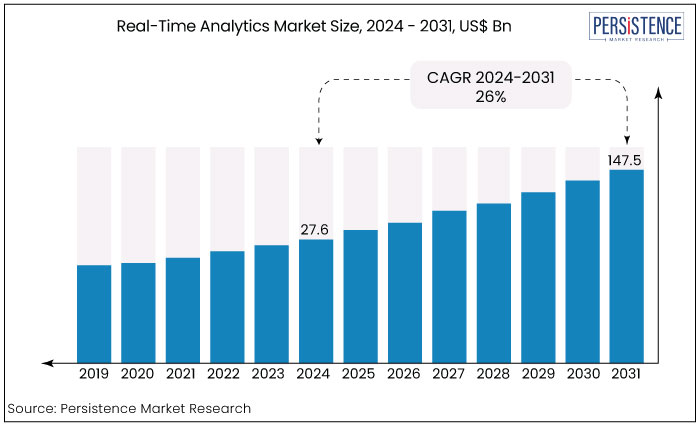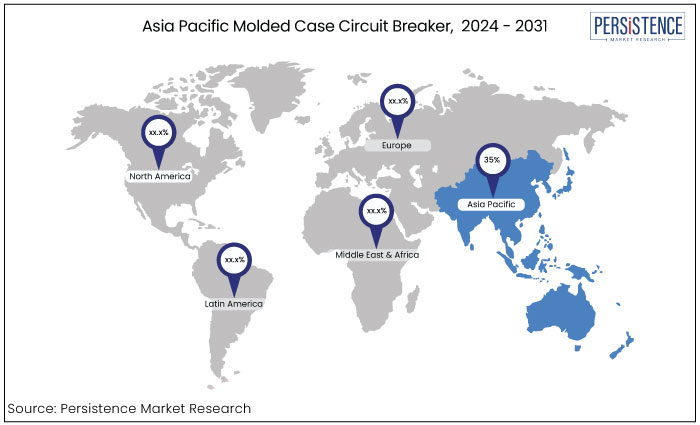Industry: IT and Telecommunication
Published Date: September-2024
Format: PPT*, PDF, EXCEL
Delivery Timelines: Contact Sales
Number of Pages: 153
Report ID: PMRREP21328
The real-time analytics market is estimated to increase from US$27.6 Bn in 2024 to US$147.5 Bn by 2031. The market is projected to record a CAGR of 26% during the forecast period from 2024 to 2031. Latest technological innovations and constant upgrades into the AI and machine learning platforms caters to the surge in demand for the real-time analytics market. The increasing demand for real-time accurate data insights is one of the key driving elements for the market over the forecast period.

Key Highlights of the Market
|
Market Attributes |
Key Insights |
|
Real-Time Analytics Market Size (2024E) |
US$27.6 Bn |
|
Projected Market Value (2031F) |
US$147.5 Bn |
|
Global Market Growth Rate (CAGR 2024 to 2031) |
26% |
|
Historical Market Growth Rate (CAGR 2019 to 2023) |
22% |
|
Region |
Market Share in 2024 |
|
North America |
32% |
North America market to accumulate 30% of the total market share. This regional market is anticipated to maintain its leading position during the forecast period. This regional growth is due to its robust technology company foundation, and extensive adoption across several industries.
Ongoing investment in breakthrough technology, strong regulatory frameworks, and significant demand for real-time insights propel market growth further in the region. Real-time analytics advances with trends like edge computing, AI/ML integration, and hybrid cloud deployments. This will impact worldwide progress in data-driven decision-making and operational efficiencies.

|
Category |
Market Share in 2024 |
|
Deployment Type - Cloud |
60% |
Based on deployment type, the real-time analytics market is classified into cloud and on premise. Among these, the cloud segment dominates the market. The cloud deployment type dominates the market in terms of revenue. The cloud deployment offers a number of benefits, including the ability to integrate quickly and to do maintenance at a low cost.
The implementation and configuration of these solutions are less complicated than that of the conventional on-premises solutions, which enables organizations to reap the benefits of their data analytics endeavors in an expedient manner.
|
Category |
Market Share in 2024 |
|
Industry - Healthcare |
30% |
The market is further categorized into manufacturing, oil & gas, healthcare, and BFSI based on industry type. Among thee, the healthcare segment dominates the market.
The advent of real-time analytics in the healthcare and life sciences sector has proved transformative particularly in enhancing patient care and operational efficiency. The increasing integration of IoT devices and real-time analytics allows healthcare providers to analyse real-time data from medical instruments.
Real-time analytics technologies enhance predictive care and promote proactive treatment strategies in the healthcare and life sciences sectors. Healthcare systems can monitor essential indicators and alert providers to recognized issues, prompting swift clinical intervention. Expanding healthcare data necessitates implementing real-time analytics to improve services and create individualized care solutions.
The real-time analytics market is one of the evolving sectors of the broad analytics market focuses on the immediate processing and analysis of data as it is produced. Real-time analytics enables businesses to obtain actionable insights and make decisions almost instantaneously, unlike traditional analytics.
The increasing volume, speed, and diversity of data produced in the contemporary digital environment has heightened the importance of this sector. Real-time analytics empowers businesses to swiftly adjust to evolving conditions, identify patterns, and capitalize on opportunities.
Advanced analytics algorithms in-memory databases, data streaming platforms, and complex event processing (CEP) systems are key components of the real-time analytics sector. Utilizing these technologies enables organizations to monitor and analyze data perpetually, hence accelerating and enhancing decision-making processes.
Real-time analytics are employed across several sectors including finance, e-commerce, healthcare, manufacturing, and telecommunications to enhance productivity, elevate customer satisfaction, and secure a competitive edge.
The real-time analytics market experienced significant growth driven by increasing demand for instantaneous data processing and decision-making during the historical period from 2019 to 2023. Early adoption was prominent in finance, retail, and telecommunications sectors, where real-time insights were critical for operational efficiency and customer engagement.
Technological advancements in big data, cloud computing, and AI fueled the expansion of real-time analytics solutions. Market growth was also supported by the rising volume of data generated from digital transactions and connected devices. However, challenges such as high implementation costs and data privacy concerns were notable.
The market is expected to witness accelerated growth with a projected CAGR surpassing earlier rates. Key factors driving this surge include advancements in edge computing, which reduces latency and enhances data processing speeds, and the proliferation of IoT devices.
Increasingly focusing on personalized customer experiences and real-time fraud detection in various sectors will boost market demand. Integrating advanced AI and machine learning algorithms will further enhance real-time analytics capabilities offering predictive and prescriptive insights.
As businesses continue to prioritize data-driven decision-making, the market will likely to see expanded applications across industries fostering notable growth and innovation.
Advancements in Edge Computing
Advancements in edge computing are a crucial driver for the Real-Time Analytics market. Edge computing involves processing data closer to its source rather than relying on a central data center. This approach significantly reduces latency, enabling faster data processing and decision-making.
Edge computing offers substantial benefits for industries like manufacturing, healthcare, and autonomous vehicles where real-time data processing is critical for operational efficiency and safety. By performing data analysis at the edge, organizations can achieve near-instantaneous insights without the delays associated with sending data to a centralized server, which reduces the risk of latency-related issues.
As edge computing technology evolves and becomes cost-effective, its adoption is expected to grow further driving demand for real-time analytics solutions and expanding their applicability across various sectors.
Proliferation of IoT Devices
The rapid proliferation of Internet of Things (IoT) devices is a significant driver for growth in the real-time analytics market. IoT devices, such as sensors, smart appliances, and wearable technologies continuously generate vast amount of data. This influx of real-time data necessitates advanced analytics solutions to process and interpret the information effectively. For instance,
In smart cities, real-time analytics is used to monitor traffic patterns, optimize energy usage, and enhance public safety by analysing data from a network of IoT sensors. Similarly, in healthcare, IoT devices track patient vitals in real-time enabling timely interventions and personalized care.
The increasing number of connected devices and the data they generate drive the demand for real-time analytics to gain actionable insights and make informed decisions quickly. As IoT adoption grows across industries, the need for robust real-time analytics solutions will continue to expand.
High Implementation Costs
One of the significant growth restraints for the real-time analytics market is the high implementation costs associated with advanced analytics solutions. Integrating real-time analytics into existing systems often requires substantial investment in hardware, software, and infrastructure.
The deployment of cutting-edge technologies such as edge computing devices and high-performance analytics platforms can be costly for organizations particularly for small and medium-sized enterprises. Also, the costs of training personnel and maintaining these systems add to the financial burden. This high cost of entry can deter businesses from adopting real-time analytics solutions limiting market growth.
While the benefits of real-time analytics can be substantial, the initial expenditure required to implement and scale these solutions poses a significant challenge especially for organizations with tight budgets or those in emerging markets.
Data Privacy and Security Concerns
Data privacy and security concerns present a notable restraint for the real-time analytics market. Real-time analytics often involves processing and analysing sensitive and personal data, which raises concerns about data breaches and unauthorized access.
Regulatory frameworks, such as the General Data Protection Regulation (GDPR) and the California Consumer Privacy Act (CCPA) impose stringent requirements for handling, storing, and protecting data. Organizations must invest in robust security measures to ensure compliance and protect against potential threats.
The complexity of securing real-time data streams and the potential consequences of a data breach can be daunting for businesses particularly those without dedicated IT security resources. These concerns can slow the adoption of real-time analytics solutions and impact market growth as companies weigh the risks and costs of maintaining data privacy and security.
Predictive Maintenance
Predictive maintenance is one of the most compelling opportunities for the real-time analytics market. Predictive maintenance leverages real-time data analytics to anticipate equipment failures before they occur enabling proactive maintenance actions.
The said approach is increasingly being adopted across various industries including manufacturing, energy, and transportation where equipment reliability is crucial for operational efficiency and safety.
By integrating real-time analytics with sensors and IoT devices, organizations can continuously monitor the health and performance of machinery and infrastructure. Data collected from these sensors is analysed in real-time to detect anomalies and patterns that may indicate potential failures.
In manufacturing, real-time analytics can monitor machinery vibrations, temperature, and operational parameters to predict when a machine will fail. This allows maintenance teams to perform repairs or replacements during scheduled downtimes, minimizing unexpected breakdowns and costly disruptions.
The benefits of predictive maintenance are substantial. It reduces maintenance costs by shifting from reactive to preventive strategies, extends the lifespan of equipment, and enhances overall operational efficiency. It improves safety by reducing the risk of catastrophic equipment failures that could lead to accidents or hazardous conditions.
As industries continue to seek ways to optimize their operations and reduce costs, the adoption of predictive maintenance solutions powered by real-time analytics is expected to grow significantly. Advancements in AI and machine learning are enhancing the capabilities of predictive maintenance solutions making them accurate and effective.
The real-time analytics market is highly competitive featuring key players such as IBM, Microsoft, SAP SE, Oracle, and SAS Institute Inc. The key companies lead through innovation and extensive product portfolios offering advanced real-time data processing and analytics solutions.
IBM and Microsoft leverage their cloud platforms to provide scalable real-time analytics services, while SAP and Oracle focus on integrating real-time capabilities into their enterprise resource planning systems.
As industries increasingly adopt real-time analytics, competition is expected to intensify with an emphasis on superior performance and customer-centric solutions.
Recent Industry Developments in the Real-Time Analytics Market
January 2024, Streams Charts, a live-streaming analytics platform, inaugurated MIRAI, an influencer advertising and marketing agency that provides advisory services, a creator partner program, comprehensive campaign management, market data, and analysis.
November 2023, ADA, a data and digital transformation firm, collaborated with Databricks, a data and AI enterprise, to enhance business value through the integration of Artificial Intelligence (AI) and data.
|
Attributes |
Details |
|
Forecast Period |
2024 to 2031 |
|
Historical Data Available for |
2019 to 2023 |
|
Market Analysis |
US$ Billion for Value |
|
Key Regions Covered |
|
|
Key Market Segments Covered |
|
|
Key Companies Profiled in the Report |
|
|
Report Coverage |
|
|
Customization & Pricing |
Available upon request |
By Deployment Type
By Industry Type
By Region
To know more about delivery timeline for this report Contact Sales

Healthcare industry employs real-time analytics the most.
It is the process of continuously analyzing data to provide immediate insights and facilitate timely decision-making.
North America retains top positon in the market.
Proliferation of IoT devices drives the market forward.
A few of the leading players in the market are IBM, Informatica, Amdocs, and Infosys.